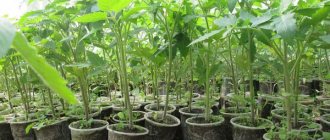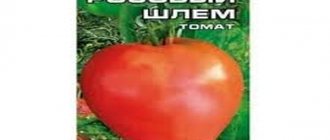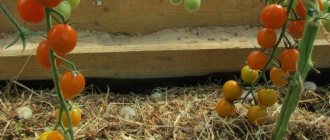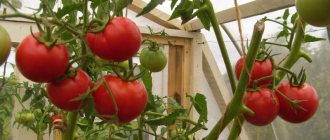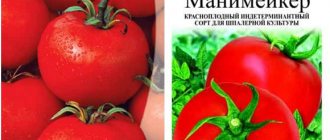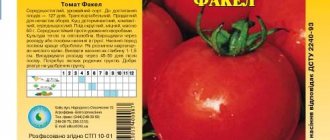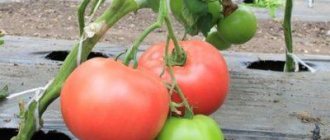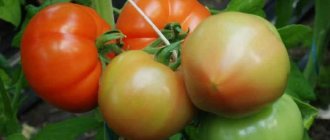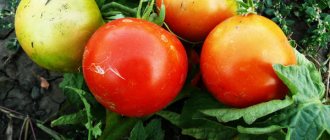Tomato Ataman is a mid-season variety bred at the Biryuchekutsk vegetable breeding station in Rostov. It is successfully grown in the North Caucasus region in conditions suitable for it, but in other areas, due to its whimsical nature, there is an ambiguous attitude towards it.
| Height | Landing location | Ripening time | Fruit color | Fruit size | Origin | Fruit shape |
| short | Greenhouse, Open ground | Mid-season | Reds | Average | Variety | Round |
Tomato Ataman
When growing tomatoes, the correct choice of variety and its compatibility with the climatic conditions of a given region are of great importance. One of the undemanding varieties is Ataman, which is suitable for growing in open ground. Tomatoes of this type are suitable for fresh consumption and further processing.
Characteristics and description of the tomato variety Ataman
The Ataman tomato variety was approved for mass cultivation in 1999. The peculiarity of the crop is its suitability for rare harvesting and mechanized harvesting without loss of marketability and taste. In addition, the vegetable tolerates transportation well over long distances.
The Ataman tomato is determinate: the growth of the bush stops after the formation of 4-5 main brushes, which are laid every 2 leaves. Therefore, growing the crop does not require large areas or special equipment.
The Ataman variety is mid-season, so from the moment of germination to the technical maturity of the fruit it will take 100-112 days. The height of the bush reaches 45 cm. The plant has medium-sized leaves and forms an intermediate inflorescence, distinguished by a stalk without articulation.
Ataman tomatoes have a round shape, dense structure and juicy consistency. As they ripen, their color changes from light green to deep red. The variety is distinguished by its friendly yield of fruits, and the yield indicator is 4-6 kg per 1 sq. m. The weight of one tomato is 85-120 g.
Note! Due to the small size of the fruits, they can be used for canning as a whole. Ataman is ideal for preservation
Ataman is ideal for preservation
Features of the composition of tomatoes of the Ataman variety:
- vitamin C - 20%;
- dry matter - 6%;
- acidity - 0.5%;
- sugar - 3.7%.
These indicators are ideal for the human body, therefore it is recommended to consume Ataman tomatoes both fresh and in the form of juice and sauce.
Features of agricultural technology
To successfully grow tomatoes, stable warm weather is required with an air temperature above 18 degrees during the day and at least 12-14 degrees at night, otherwise the growth and development of the bush will slow down. Therefore, it is recommended to plant the crop as seedlings - no earlier than the first half of March, and in open ground - in mid-May.
Ataman needs moderate air humidity, about 60%. As this indicator increases, flower pollination and fruit set slow down significantly, and the likelihood of infection with fungal diseases (late blight, blackleg) also increases.
Note! It is preferable to grow the crop on sandy and loamy soils, which guarantees the full development of the plant and the formation of fruits. Before planting seedlings in a permanent place, it is recommended to prepare the beds 2 weeks in advance by digging with a shovel
During this period, the plants must be adapted to external conditions, which will protect them from hypothermia in the future and prevent the inflorescences from falling off. The planting density is 4 plants per 1 sq. m
Before planting seedlings in a permanent place, it is recommended to prepare the beds 2 weeks in advance by digging with shovels. During this period, the plants must be adapted to external conditions, which will protect them from hypothermia in the future and prevent the inflorescences from falling off. The planting density is 4 plants per 1 sq. m.
Important! When air humidity is high, it is necessary to carry out preventive treatment of tomatoes against fungal diseases, starting 2 weeks after planting in open ground. Ataman needs preventive treatment at high humidity
Ataman needs preventive treatment at high humidity
Advantages and disadvantages
According to the description of tomatoes of the Ataman variety, the following advantages of the crop can be identified:
- excellent taste of the fruit;
- versatility of use;
- the possibility of rare harvesting and mechanized one-time harvesting;
- friendly ripening of fruits;
- compactness of bushes;
- resistance to transportation without loss of commercial properties.
The disadvantages of the variety include relative susceptibility to late blight and blackleg at high humidity levels.
Ataman tomatoes are ideal for growing both at a summer cottage and on an industrial scale in the southern regions and in the middle zone of the country.
Auria tomatoes on video
This variety is not included in the state register of breeding achievements in the Russian Federation.
Reviews from those who planted Auria tomatoes are unanimous in that they are not prone to cracking and are ideal for preservation. A very productive variety; there can be up to 14 clusters on a bush.
This is a natural variety of tomato. Therefore, we recommend taking seeds from a ripe fruit and using them for planting in subsequent seasons.
If you grew these tomatoes, please write whether you liked them or not. What was the yield and taste of the fruits like under your climatic conditions? How do you rate the disease resistance of this variety? Briefly describe the advantages and disadvantages of this tomato in your opinion. If possible, attach to the comment a photo of the entire bush as a whole or individual fruits that you grew. Thank you!
View All tomatoes in alphabetical order with photos >>> Catalog
Recommendations for planting and care
It is advisable to plant seeds in late February-early March. Handsome tomatoes can be planted both in the ground outside and in a greenhouse. In addition to soil, you can use clay or sandy soil.
Seedlings can be picked only after the appearance of the second true leaf.
Plants should be hardened off 1-2 weeks before planting in the ground. First, ventilate the room, then expose the seedlings to the open air for a short time.
The summer resident who planted this tomato variety will definitely advise tying up the plants as soon as they reach a height of 50 cm.
It is advisable to remove excess shoots and stepsons and form branches into one bush.
Description of the tomato variety Sevryuga (Pudovik), its characteristics and yield
Read
When the sixth cluster appears, it is recommended to remove the growing point of the bush by cutting off the top leaves and leaving 2 leaves at the top.
You can feed tomatoes 2-3 times per season with inorganic fertilizers containing potassium, nitrogen, phosphorus, copper (copper sulfate).
During the tomato growing season, you should water them with warm water after sunset. From the description above it is clear that the Krasavchik f1 variety is quite difficult to grow. When the bushes reach a height of 40-50 cm, the ground needs to be weeded and hilled.
Reviews from gardeners
Reviews from those who planted this variety are mostly positive. Gardeners note that when growing, it is necessary to observe the temperature regime. To do this, you need to plant tomatoes later. People also note the high yield of the variety and excellent taste.
Ataman tomatoes can be grown in large quantities, not only for personal consumption, but also for sale, since if there is a suitable temperature and the required humidity level, you can get a bountiful harvest of this plant.
Gardeners note that tomatoes of this type do not require cultivation in greenhouse conditions, which means there is no need to build a greenhouse or greenhouse. The plant does not require too complex agrotechnical measures. The main thing for tomatoes is warmth, so they should be planted no earlier than the end of March or beginning of April.
Yellow, large, aromatic fruits - Monastic Meal tomato: full description of the variety
The Monastic Meal tomato is loved by gardeners due to its unsurpassed sweet taste with virtually no sourness. Fleshy orange fruits perfectly complement any salads and vegetable dishes.
| Height | Landing location | Ripening time | Fruit color | Fruit size | Origin | Fruit shape |
| Medium height | Greenhouse, Open ground | Mid-early | Orange | Average | Variety | Round |
Description and characteristics of the variety
Tomato Monastic meal is a new variety created in Russia by Siberian breeders. It has been listed in the State Register since 2011. It can be grown in all regions, only in the south it will grow in open ground, and in Siberia, the Non-Black Earth Region, and in the climate of the middle zone, a greenhouse will be required.
Characteristics of plant bushes: determinate, reach a height of 1 meter, and in greenhouses 1.3 meters, non-standard. Description of the fruits: ripen in the mid-early period, 90-110 days after germination of the seed, the harvest grows. Tomatoes have a round shape, slightly flattened at the top and bottom. The color is bright orange, the skin is smooth. The fruits weigh on average 140-180 g, but with intensive care and feeding you can get the largest ones up to 400 g. There are about 6 seed chambers, but there is not much juice.
They are mainly used for preparing salads and various vegetable dishes. You should not preserve it, as the pulp disintegrates and the fruits are not juicy enough for juice. However, they make good pastes.
Advantages and disadvantages
- excellent taste;
- beautiful and bright appearance;
- large fruit;
- dietary properties;
- ability to tolerate lack of lighting.
Minuses:
fruits may crack.
Features of cultivation and storage
Plants need to be pinched into 2-3 stems. They are tied to a support.
You can plant not only in the ground, but also in spacious containers.
For 1 sq. m. 4 bushes are placed.
The fruits do not last very long, but they can last up to 30-40 days in the refrigerator. Store them by placing them in wax paper or wrapped in it. Tomatoes are relatively resistant to transportation.
Planting and care
Tomatoes are planted as seedlings 50 days before transferring the seedlings to a permanent location. Seeds and soil are treated before this to disinfect. The grains are soaked in a solution of potassium permanganate, hydrogen peroxide or aloe juice, then washed with water and treated with a growth stimulator
This is important, since the Monastic Meal variety can suffer from diseases, and disinfection helps increase immunity
The soil is prepared from turf soil mixed with a portion of sand, as well as peat or humus with the addition of wood ash and superphosphate. The substrate is spilled with a solution of potassium permanganate or calcined in an oven.
The grains are covered with a 1-2 cm layer of soil. Sprayed with water from a spray bottle, covered with film and kept in a room with a temperature of +22-24 degrees. In a week the first shoots will appear. After this, the boxes are opened, moved to a well-lit window sill and the temperature is lowered to +18 degrees. It is kept at this level for a week, then raised again.
At the stage of 2 permanent leaves, the bushes dive.
7-10 days before transferring to the greenhouse or garden, harden the tomatoes by placing the boxes in the sun, first for half an hour a day, then increasing the time.
Care includes watering, regular fertilizing, loosening the soil and weed control.
Description of the variety
The main characteristics worth highlighting are:
- fruit roundness;
- the presence of a green spot that disappears during ripening;
- atypical reddish-yellow color of tomatoes;
- the weight of tomatoes - the weight of one can reach 300 grams;
- tough skin;
- a small amount of seeds;
- fast ripening times;
- versatility of use for food purposes.
The main purpose
The Astrakhan orange tomato is suitable for both fresh consumption and canning. Its taste properties can be adjusted independently depending on your preferences. For example, if you pick the fruits on time, the flesh will be sweetish, but if you wait a little and remove them later than the appointed time, they will acquire a pleasant sourness that can be organically combined with many dishes.
Productivity
From one bush you can collect up to 2 kg. tomatoes. Considering that the variety begins to bear fruit at the end of July and ends with the first autumn frosts, it is quite easy to get a rich harvest.
Landing
It is necessary to start preparing seeds in March, that is, 65-70 days before planting plants in open ground.
When choosing canopies, you should pay attention to their shelf life (at least 2 years) and manufacturer. Unlike other varieties, Astrakhan orange tomato seeds can be sown in the soil from the garden bed, rather than buying store-bought ones. To prevent the development of various diseases, it is best to treat the soil with antimicrobial agents; they can be purchased at any gardening store, or warm the soil in the oven and calcine it for 20 minutes.
To prevent the development of various diseases, it is best to treat the soil with antimicrobial drugs; they can be purchased at any gardening store, or warm the soil in the oven and calcine it for 20 minutes.
The seeds are also good because they do not require pre-soaking in gauze. In order to activate growth, it is necessary to place the soil in peat pots and make small grooves no more than 1 cm deep.
ATTENTION! You should not put a lot of seeds in one pot. Germination reaches 90% and thickening with seeds can lead to negative consequences.
After the seeds are placed in the soil, it must be well moistened and covered with film.
Then check the humidity daily and water if necessary. As soon as the first green shoots appear on the surface, the film must be removed
After the seeds are placed in the soil, it must be well moistened and covered with film. Then check the humidity daily and water if necessary. As soon as the first green shoots appear on the surface, the film must be removed.
The Astrakhan orange variety needs picking, so as soon as several full leaves appear, the plants are planted in different pots.
The signal for transplanting into open ground will be:
- tomato height - at least 15 cm;
- at least 7 leaves per stem;
- absence of night frosts;
- May weather.
It is necessary to plant 3 bushes per 1 sq.m. Although the distance may seem too far, don't worry, the bushes will gain strength and fill the space.
The most common and convenient scheme is where:
- between rows the distance is no more than 40 cm;
- between holes - no more than 30 cm;
- passage between rows - 70 cm.
This way the bushes will grow freely, and make the process of watering and processing tomatoes easier for yourself.
Description of the tomato variety Barmaley, its cultivation and care
Culture is indispensable in many areas. Tomato "Barmaley" is a bright representative of the early-ripening tomato variety. Large fruits are suitable for preparing the first summer salads.
Basic ideas about the variety
Before planting this or that species, the summer resident looks for detailed characteristics. This information gives basic concepts about the variety. Helps you choose the right place for it on the site.
- High 2 m.
- Belongs to the indeterminate type.
- Ripens within 98–100 days.
- Flat-round shape.
- Weighs from 200 to 300 g.
- Color pink.
- The taste is tomato, slightly sweet.
- Average density, 2–3 chambers.
- Transported and stored well.
Growing and care
It is better to plant tomatoes using seedlings. Each summer resident calculates the period individually. Based on the climate characteristics of the planting location. The seedlings are ready in 55–60 days.
When 2 true leaves appear on the plants, they dive. Separate containers allow tomato seedlings to form a normal root system and a powerful stem. This is the foundation of the future harvest.
Tomatoes should be planted in the ground at the rate of 3 plants per 1 m2. There is no need anymore, they will not allow each other to develop normally. The bushes are tied to supports. Sewing is a must; manufacturers recommend forming them into 1–2 stems.
Necessary agrotechnical practices:
Watering. The water is warm, it’s evening time. Weeding. Prevention against insect pests. Loosening and mulching retains moisture. Fertilizing using organic matter or complex fertilizers.
Tomato Ataman: variety description
The Ataman tomato is a variety that requires special care. Let's consider the characteristics and description of the Ataman tomato variety.
Description of the tomato variety Ataman
Tomatoes are mid-season, they can be grown in open ground, but only in regions where frosts and cold weather do not occur at this time. The plant is determinate, meaning it does not require much space to grow. The time period from the emergence of seedlings to the ripening of the harvest is about 100-110 days.
Characteristics of Ataman tomatoes:
- Ataman is a tomato with small fruit sizes.
- The weight of 1 tomato is only about 120 g.
- The plant has an intermediate inflorescence; the stalk has no articulation.
- The fruits are round in shape and have a smooth surface.
- The fruit pulp is juicy, high density, with a low seed content.
- Unripe tomatoes are light green in color, while ripe ones are bright red.
- The fruit inside contains more than 4 sections.
- Tomatoes have a pleasant delicate taste.
Khan - variety of tomato plant
Information about the admission of Tomato Khan from the Register of the State Variety Commission of the Russian Federation
Application for admission No. 40300, registered 2003-11-21. The Tomato Khan variety was included in the register of approved varieties in 2004. Approved for use in the regions: Northern, Northwestern, Central, Volga-Vyatka, Central Black Earth, North Caucasus, Middle Volga.
The originator of the Tomato Khan variety is:
Other varieties of tomato plant
Question to the portal experts
If you haven't found the answer to a question, don't hesitate to ask an expert.
Register or Login so you don't have to enter your Name and Email every time
Thanks for the comment! It will be published after checking by a moderator!
No comments yet, be the first!
A portal for those who love their dacha
Your question has been sent for moderation. Don't worry, we quickly check your questions and your question will be answered within 1 day.
We have noticed that you are already registered on our website. We recommend that you log in to view the created question.
If you don't remember your password, you can recover it.
You were not registered until today, so we have registered you. Your password has been sent to your specified mailbox.
Help our site develop!
Please read this message, it will not take up much of your time!
We so need your comments and questions to understand in which direction we should develop.
Don't forget to leave a comment if you found what you were looking for. And if you haven’t found it, use the “Ask an Expert” form in the site header. We will answer this question, and other visitors will be able to find the information that you could not find.
Your question has been sent for moderation. Don't worry, we quickly check your questions and your question will be answered within 1 day.
We have noticed that you are already registered on our website. We recommend that you log in to view the created question.
If you don't remember your password, you can recover it.
You were not registered until today, so we have registered you. Your password has been sent to your specified mailbox.
Description and characteristics of the variety
Vano F1 tomatoes are classified as early ripening varieties. From the moment of the first shoots to the receipt of the first ripe fruits, an average of 100 to 105 days pass. The plant is determinate, reaching a maximum size of 90-100 cm.
The bushes have a compact appearance, the trunk is strong, the branches are not spreading, slightly directed upward. Experts recommend forming a bush into 2 trunks.
Vano tomatoes are grown both in greenhouses and greenhouses, and in open ground. In greenhouse conditions and subject to all agricultural requirements, larger and more massive fruits can be obtained.
The tomato inflorescence is ordinary, collected in one raceme. The first brush is formed above the 6-7 leaf, then after 1-2 leaves. In order for the fruits to be large and juicy, it is necessary to carry out pinching.
The fruits of the Vano F1 variety are large and have a round shape. Their weight can reach 200 g. A ripe tomato has a pink, almost raspberry color, the flesh is juicy and dense with six seed chambers.
The tomato skin is thin and smooth. Despite this, tomatoes tolerate transportation well and are stored for at least 2-3 weeks. Vano tomatoes can be picked green. He is able to ripen on his own.
The taste of tomatoes is excellent. The fruits are perfect for fresh consumption and for preparing various tomato products.
The description of the Vano variety indicates that the plant has good resistance to various fungi and pests. Thanks to its rapid growth and maturation, the bush avoids late blight.
Description of the Roma tomato variety, cultivation and care
Read
You can grow the crop on your site using seedlings.
Fruit characteristics
As mentioned earlier, Ataman tomatoes have small bushes (maximum 45 cm).
Therefore, the leaves are medium-sized, green and the fruits are small. Their maximum weight is 120 grams. The tomato inflorescence is intermediate, the stalk is without articulation. Fruit characteristics: round, smooth, dense, juicy. And these are not all of his positive features. Its color when unripe is light green, and when ripe it is deep red. It has more than four nests. Tomatoes have a wonderful taste, both fresh and canned. Due to the fact that the fruits are small in size, they are perfect for whole preservation.
A planted tomato bush can produce a harvest of up to 10 fruits. This is a good indicator. The total amount per hectare is up to one hundred tons. It is very rare to find bad tomatoes in the harvest. Thanks to their resistance to diseases, everyone survives under normal conditions.
Description of unusual black Kumato tomatoes and features of growing the variety
Among tomatoes there are dark-colored varieties. Some of them have this color due to the combination of red and green tones, but black Kumato tomatoes belong to a different category. The black-skinned berries contain large amounts of anthocyanin pigment, giving them a color similar to that of eggplant skin.
General description of the plant
The Kumato variety is a plant bred by European breeders and known throughout the world. Unusual black fruits are grown in Turkey and a number of European countries, but tomatoes have been known in Russia for about 10 years. The variety is not included in the State Register of Breeding Achievements of Russia.
The plant is heat-loving; in the conditions of central Russia, it bears fruit well only in protected soil. Due to the relatively late ripening period (about 120 days from germination), in open ground it will not be able to ripen in time and collect a sufficient amount of sugars. Kumato tomatoes can only be truly appreciated when cultivated in a greenhouse.
The bush is indeterminate, tall (up to 2 m or more). The plant is formed into 1-2 stems with a garter to the trellis. In order for more nutrients and sunlight to reach the fruits, the leaves below the developing flower cluster must be removed.
The variety is resistant to major tomato infections that spread in the warm and humid microclimate of the greenhouse. Dark fruits are not affected by Alternaria, and the green parts of the bush are resistant to the mosaic virus. Tomato tolerates high air temperatures well.
The average yield is 7-8 kg of vegetables from 1 bush. Compacted plantings are not used for Kumato, so only 2-3 bushes can be planted per 1 m². With a higher planting density, tomatoes produce a smaller yield.
Features of the variety fruits
Tomatoes are small in size and round in shape. Kumato occupy a middle position between cherry tomatoes and ordinary varieties with medium-sized fruits. The weight of 1 berry is about 80 g, the diameter is 4.5-5 cm. The fruits on the cluster and on the entire bush are almost the same in size and weight, their number on a branch is usually 8-10 pieces.
The skin is very dense and durable, with a rich brown-violet hue when biologically ripe. Unripe tomatoes are dark green; in the blanzhe stage they acquire a brown tint. Tomatoes do not crack when ripe, tolerate long-term transportation well and are stored for at least 2 weeks without losing their presentation. Tomatoes can ripen after being picked from the bush, practically without losing their taste.
The taste qualities are highly rated. Gardeners who have already grown black tomatoes note a sweet taste, almost complete absence of acid and a rich fruity aroma reminiscent of blackberries or prunes. The beneficial properties of the Kumato tomato variety include a high content of anthocyanins, which are beneficial for vision and have antioxidant properties (rejuvenate the body). In addition, tomatoes contain a set of vitamins and microelements, sugars and proteins that are beneficial for humans.
Black tomatoes are considered an exotic gourmet vegetable. They are used only fresh, including unusual fruits in gourmet snacks, holiday cuts and salads. A vegetable grower who plants them on his plot will be able to include Kumato in his daily diet and surprise his guests with unusual tomatoes. But in household use, the Kumato tomato variety is often used as the most common red tomatoes.
Surplus products can be stored for the winter. Black berries do not lose their structure during pickling and can beautifully complement the color scheme of assorted vegetables. Tomatoes of this type are convenient to dry: they contain a lot of dry matter and a small amount of juice, so the product will be of high quality. Unripe but already colored Kumato will make a beautiful exotic jam.
How to grow black tomatoes?
The Kumato tomato is grown according to the rules common to all tomatoes. Sowing of seeds is carried out 50-60 days before the intended planting in the greenhouse, so that the seedlings do not have time to stretch out. The soil is prepared from equal parts of sand, humus and fertile soil. The mixture is heated in the oven or soaked in a hot solution of potassium permanganate.
My favorite tomato varieties
January and February are the right time to select and purchase tomato seeds, which we will sow in March. I have been growing tomatoes in a greenhouse and in open ground for only 6 years, but I have already managed to create my own hit parade of tomato varieties.
There are must-have varieties that I always plant every year. I like them not only for their taste and unpretentiousness, but also for the way they look on the bush. I’ll paraphrase one bearded joke: “I don’t really like tomatoes... But the process itself...”. I love going into the greenhouse and admiring the tomato plantations. And I don’t hesitate to show off my particularly spectacular huge tomatoes to my neighbors, and then post photos on the forum. It’s a shame to hide it – we all love it!
READ MORE: Mangalitsa pigs characteristics photo reviews about the breed
The following varieties are among the favorites also because they do not need to be fanatically cultivated and shaped. And they will always give a harvest: small, large, and a lot, depending on the variety and what I grow them for - for salads, for preparations, or, the smallest and sweetest ones, so that “like seeds, they click.” .
The “Rocket” variety is suitable for both greenhouses and open ground. The fruits are identical in shape and sweet. We love to eat them by the handful. Look good in blanks. The bush requires garter, despite the fact that the package says the opposite. This is because a lot of fruits grow, and the bush bends from the weight. Its height in open ground is about 40 cm, and in a greenhouse it can reach up to 60 cm. This is a mid-season variety; it does not need to be pinched.
Rice. 1. “Rocket” matures smoothly and is well stored in both technical and biological maturity.
I got the “Big Man” variety from a neighbor. During a tour of her greenhouse, I really liked the way it looked on the bush. The neighbor said that she has been planting it for a long time, that it is unpretentious and always sets fruit, even if the ventilation regime in the greenhouse is not followed. Of course, I took one fruit for seeding. “Zdorovyak” can grow up to 100 cm in height, so it is better to grow it in a greenhouse, although it produces large tomatoes in open ground.
Rice. 2. There is almost no need to pin the “Big Man” wrist.
Rice. 3. It ripens in batches, gradually, which is very convenient.
Among the vigorous-growing tomatoes with large fruits, I singled out the “Red Giant” variety. This amateur variety was bred by simple gardeners. Despite the fact that it grows a lot of leaves, it does not have to be pruned too often. The fruits on the lower tiers are the largest. If I had not been lazy and plucked out the inflorescences, leaving no more than 3-4 in the brush, the fruits would have been even larger. It is fleshy inside and contains few seeds.
Rice. 4. “Red Giant” in mid-July.
Rice. 5. You can take your own seeds, but the fruit must ripen on the bush and come from the second cluster from the bottom.
Rice. 6. The fruits are slightly ribbed, quite transportable, there is never a yellow-pink top from unbalanced care, as in pink-fruited varieties.
Rice. 7. Both the side of the stalk and the reverse side always have a marketable appearance.
Rice. 8. The only drawback of the “Red Giant” is that the largest fruits require a garter.
However, almost all large-fruited tomatoes require additional tying of the brushes. Except for my next favorite, Bull's Heart. I also always grow it year after year, as my grandmother advised me. “He will never let you down!” - she said, and every year I am convinced of this. Even if I took my own seeds and not factory ones, “Bull’s Heart” invariably bears fruit and does not require pinching at all, although it is vigorous.
Rice. 9. The hands grow in such a way that they do not need to be additionally secured with a garter to prevent them from falling.
Rice. 10. There is one peculiarity of the “Bull’s Heart” - a predisposition to the formation of such gnarled fruits.
Therefore, if you see a bud or flower that is too large, feel free to cut it with scissors, it will still take a long time to ripen, even though it will be large, the skin will be hard and gray, you cannot take seeds from it.
Rice. 11. But the bulk of the “Bull’s Heart” fruits are very beautiful, tasty and fleshy. By the way, this variety comes in both orange and red.
I definitely plant the listed varieties, but there are also some that I just liked, and I periodically grow them in the greenhouse, but I have not become a fan of them. Of the indeterminates, I like the raceme varieties the most. Again, this is primarily because they look beautiful on the bush. There are only three varieties, and each has a special reason to grow it.
“Intuition F1” is a mid-season hybrid, but I would classify it as a late-season hybrid. Not only does it reach harvest ripeness only by mid-August, but biological maturity also comes quite late. Some specimens of these tomatoes ripen even until the end of October. But, on the other hand, this is convenient because as a result, we have our own fresh tomatoes at home for a very long time. That's why I sow it in February.
Rice. 12. Photo from the end of July, but the fruits have not yet begun to ripen.
But “Intuition F1” is very easy. This hybrid is great for freezing for future use. In winter, I make pizza and frittata with them, as they do not defrost like porridge, but retain their meatiness well when cut.
Rice. 13. The fruits are all smooth and beautiful.
Rice. 14. In this form, I send “Intuition F1” to deep freeze.
“Scarlet Candles” is a cluster variety, mid-season. They don’t have a special taste, but what a shape! Looks impressive in preparations with cucumbers. However, this is why I grow them. It’s nice to admire such a jar later in the winter.
READ MORE: Tomato snowman f1 description and characteristics reviews with photos
Rice. 15. The length of “Scarlet Candles” is almost like pickling cucumbers.
Rice. 16. “Scarlet candles” look neat, they all have a characteristic “spout”.
“De Barao” is quite late-ripening; I sow it earlier than the bulk of tomatoes. I really like it in preparations, it does not crack and is very tasty, both fresh and pickled.
Rice. 17. "De Barao" is resistant to disease. I always plant it on the north side, tying it above the entrance to the greenhouse, because it is very tall, and the upper tier ripens even in the last ten days of August, despite the first cold nights.
Rice. 18. The fruits are beautiful, all as one.
I have tried a great variety of salad varieties, I still want to find the most delicious one. Of the unusually colored tomatoes, I really like the taste of “Malachite Box” and “Black Prince”. Both are tall and require pinching, gartering, and formation into 1-2 stems, but the effort is worth it, the fruits are magnificent. “Black Prince” is dark burgundy when fully ripe.
Rice. 19. “Malachite box” in biological maturity – green.
Rice. 20. All these “Malachite Box” tomatoes are already ripe, although in appearance they seem unripe.
The yellow giants are not inferior in taste, of which the most fleshy and tasty for me are “Yellow Truffle” - of an unusual shape, “Persimmon” - indeed, the pulp is cut like the fruit of the same name, “Golden King” and sweet like a melon, “ Golden Bull." “Golden Heart” and “Altai Yellow” were less impressive. But it should be noted that the shelf life of yellow tomatoes is inferior to red ones.
Rice. 21. Everyone looks the same on the bush. This is Cardinal.
Rice. 22. “Cardinal” is well kept.
Rice. 24. In the foreground is “Mazarin”. It differs only in shape, in taste - like all other red-fruited ones.
Rice. 25. “Altai Reds”, however, can be praised for their friendly maturation.
Separately, I would like to mention the pink-fruited tomatoes “Miracle of the Earth”. If you are lucky with the summer and it is not very hot, then you can get a good harvest from this variety.
Rice. 26. “Miracle of the Earth” are also tall.
But, if there is not very good ventilation in the greenhouse, then this variety will give a characteristic light yellow border, I don’t like it, and I cut it off before use.
Rice. 27. “Miracle of the Earth” - on the right. They are the same size as the Red Giant on the left.
Separately, it should be said about tall cherry tomatoes, for example, “Chio-chio-san”, “Sweet Cherry F1” and others. Yes, many of them are sweet, they look elegant both in the greenhouse and in pickles, but many of them are thrown away and require careful care. No matter how much I refuse to plant them, I still “break down”, I really want to admire the brushes.
Rice. 28. “Red date” is, of course, delicious.
Rice. 29. “Goldilocks” also tastes good if you resist and don’t eat it half-ripe - and it can be eaten even half-ripe.
Among the tomatoes for growing outside, I liked only five. Although all tomatoes for open ground can be grown in a greenhouse, if there is space. It is simply more efficient to occupy a greenhouse not only in width, but also in height, so it is customary to place low varieties outside, under temporary shelter or without it at all.
The hybrid “Market King III F1” got its name for a reason. I grow it under cover and without, depending on how much space remains in the greenhouse after the main plantings. It is considered early ripening, although I would not say so. I plant it with pleasure, because in any summer - both cloudy and hot - it produces a stable harvest.
Rice. 30. “Market King III F1” produces aligned fruits (in the red basket).
Rice. 31. “Apple tree of Russia” on a bush.
Rice. 32. “Apple Tree of Russia” stores well, including when frozen.
Rice. 33. “Buyan” is a long-known trouble-free variety for open ground.
Rice. 34. “Buyan” is good for pickling.
Rice. 35. I bought “Leningrad Chill” in economical packaging - 200 seeds in one. It lived up to its name, did not freeze during frosts, and grew well both in the greenhouse and outdoors.
Rice. 36. But the yellow-fruited variety “Wonder of the World” turned out to be the most cold-resistant for open ground. It sets an incredible amount of fruit.
From the low ones I also tried “Kremlin F1”, “Peach”, “Orange Sun”, “Dushechka”, “Tiger”, “Sanka”. Despite the hype, these varieties disappointed me.
Description and agricultural technology for growing tomato variety Ataman
The Ataman tomato is a variety that requires special care. Let's consider the characteristics and description of the Ataman tomato variety.
Description of the tomato variety Ataman
Tomatoes are mid-season, they can be grown in open ground, but only in regions where frosts and cold weather do not occur at this time. The plant is determinate, meaning it does not require much space to grow. The time period from the emergence of seedlings to the ripening of the harvest is about 100-110 days.
Characteristics of Ataman tomatoes:
- Ataman is a tomato with small fruit sizes.
- The weight of 1 tomato is only about 120 g.
- The plant has an intermediate inflorescence; the stalk has no articulation.
- The fruits are round in shape and have a smooth surface.
- The fruit pulp is juicy, high density, with a low seed content.
- Unripe tomatoes are light green in color, while ripe ones are bright red.
- The fruit inside contains more than 4 sections.
- Tomatoes have a pleasant delicate taste.
Tomatoes are used fresh, for preparing salads, and for pickling in general, since the fruits are small in size. The Ataman tomato is used for preparing sauces, seasonings, spices, first and second courses. They can be fried, boiled, stewed. Dishes using tomatoes of this type are very tasty and aromatic.
How to grow Ataman tomatoes?
When growing, the variety requires compliance with the temperature regime. These tomatoes love warm weather and sunshine. Good productivity of this species is possible only when the plants grow in warm conditions.
Humidity should be no more than 60%. In the first 10 weeks of growing tomatoes, the air humidity should be 65%. If the humidity is higher, pollination of the ovary will be worse. Flowers will fall off, and bushes may become infected with fungal diseases. For example, diseases such as late blight and blackleg are common.
Yield varieties of tomatoes for greenhouses and open ground
Until recently, gardeners had no problems choosing a tomato variety, because they had to be content with the availability of available seed. Twenty years ago the range of tomatoes was small.
Now so many varietal and hybrid varieties of this crop have been bred that it is difficult to choose the right ones from such a variety. The seed packages depict luxurious bushes with bunches of beautiful tomatoes. The description promises a rich harvest and excellent taste.
However, the qualities of certain tomato varieties declared by seed producers do not always correspond to reality. This is explained by the incorrectness of their choice for a given region with certain climatic conditions, the method of cultivation (greenhouse or open ground), and the applied agrotechnical conditions for growing tomatoes.
READ MORE: Tomato capsule characteristics and description of the variety, yield with photos
Before choosing seeds of suitable varieties, you need to decide on several factors:
- Local climate. The reason that good high-yielding varieties bear little fruit may be their inadequacy for a given region. Thus, Siberian types of tomatoes, which are distinguished by their tolerance to unfavorable temperature conditions, diseases, and pests, can produce full harvests in any climatic conditions. But southern varieties will bear little fruit in cold areas, even in greenhouses; some will not grow at all. The high yield indicators declared by sellers correspond to reality only in those regions where plants have a long growing season, when several harvests can be harvested from one bush.
- Where will the tomatoes grow - in a greenhouse or open ground. This question is very important. There are few universal varieties of tomatoes that can bear fruit equally well in stationary greenhouses and in the fresh air. Most species of these plants are adapted only to certain conditions. Therefore, you need to be especially careful when choosing seeds based on these indicators.
- The purpose of cultivation is for salads, canning or for sale. If you prefer to provide your diet with fresh tomatoes during the season, which are distinguished by their excellent taste and nutrient content, choose salad varieties. But such tomatoes are not stored for a long time and are not suitable for preservation. For preparations for the winter, it is better to choose special ones, which are medium and small in size, denser pulp, and strong peel. The taste and percentage of nutrients are noticeably lower than that of salad vegetables. There are even fewer of them in varieties for commercial cultivation - they are characterized by a long shelf life, high yield, in which their properties are reduced due to the number of fruits.
- Bush shape - low-growing (determinant) or tall (indeterminate) varieties. Tomatoes whose bush height is 50-70 cm are considered determinant. They are also found lower. Their cultivation is suitable for “lazy” and novice gardeners. Because such plants do not require much hassle with pruning and tying, some of them do not need to be tied at all. Indeterminate varieties are convenient to grow in small areas, but they require careful care for the formation of bushes, regular correct pinching, and for them you need to create special supports for garter. They grow up to 1.5 m or more.
- When is the harvest planned? To provide your summer diet with fresh tomatoes, choose early salad varieties. For harvesting, medium and late varieties are planted. In total, experienced gardeners grow several types of tomatoes on their plots, so as not only to receive fresh vegetables for the table all season, but also to insure themselves if any of them turns out to be low-yielding.
Having a good greenhouse at your disposal, you can get fresh tomatoes to your table all year round.
To do this, several varieties are planted with different ripening periods.
